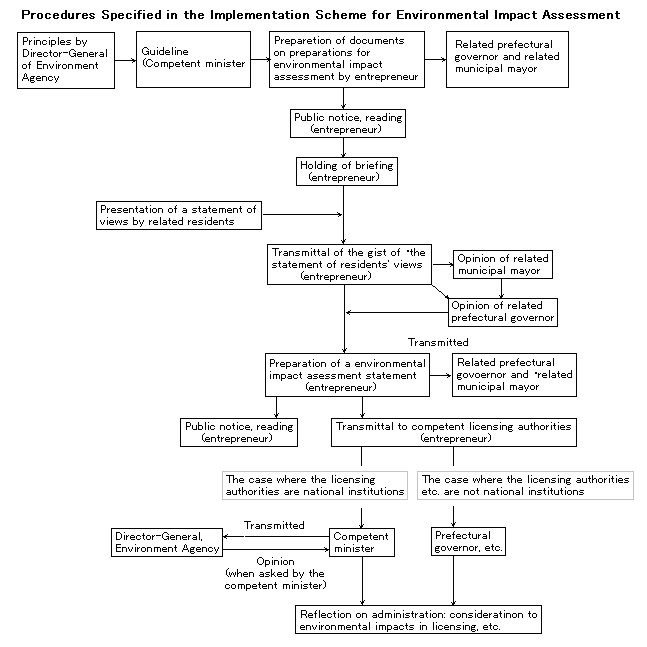The Ministry of Environment and Forests (MoEF) of India have been in a great effort in Environmental Impact Assessment in India. The main laws in nation are
· Water Act(1974),
· The Indian Wildlife (Protection) Act (1972),
· The Air (Prevention and Control of Pollution) Act (1981) and
· The Environment (Protection) Act (1986).
The responsible body for this is Central Pollution Control Board. Environmental Impact Assessment (EIA) studies need a significant amount of primary and secondary environmental data. The primary data are those which need to be collected in the field to define the status of environment (like air quality data, water quality data etc.). The secondary data are those data which have been collected over the years and can be used to understand the existing environmental scenario of the study area. The environmental impact assessment (EIA) studies are conducted over a short period of time and therefore the understanding the environmental trends based on few months of primary data has its own limitations. Ideally, the primary data has to be considered along with the secondary data for complete understanding of the existing environmental status of the area. In many EIA studies, the secondary data needs could be as high as 80% of the total data requirement. EIC is the repository of one stop secondary data source for environmental impact assessment in India.
The Environmental Impact Assessment (EIA) experience in India indicates that the lack of timely availability of reliable and authentic environmental data has been a major bottle neck in achieving the full benefits of EIA. The environment being a multi-disciplinary subject, a multitude of agencies is involved in collection of environmental data. However, there is no single organization in India which tracks the data available amongst these agencies and makes it available in one place, in a form and manner required by practitioners in the field of environmental impact assessment in India. Further, the environmental data is not available in value added forms that can enhance the quality of the EIA. This in turn adversely affects the time and efforts required for conducting the environmental impact assessments (EIAs) by project proponents and also timely environmental clearances by the regulators. With this background, Environmental Information Centre (EIC) has been set up to serve as a professionally managed clearing house of environmental information that can be used by MoEF, project proponents, consultants, NGOs and other stakeholders involved in the process of environmental impact assessment in India. EIC caters to the need of creating and disseminating of organized environmental data for various developmental initiatives all over the country.
EIC stores data in GIS format and makes it available to all environmental impact assessment studies and to EIA stakeholders in a cost effective and timely manner.

Environmental Impact Assessment Notification
The Environmental Impact Assessment Notification of 2006 (amended in July 2004 to incorporate new and expansion/modernization projects; originally enacted in 1994) under the Environment (Protection) Act of 1986 requires that a scheduled list of projects and activities must provide for public consultations and receive prior environmental clearances from the Ministry of Environment and Forests (MoEF), the environmental arm of India’s Central Government. However, there are blatant loopholes in this spineless attempt to prioritize the welfare of the environment over the continuous blossom of construction for the sake of economic development.
It has been cited in several case studies that the Yamuna River suffers from severe anthropogenic pressures, such as civic construction, alteration in landscape pollution, change in nature of vegetation, and over-exploitation of species and agriculture, which has severely diminished the river’s capacity to be a reliable source for drinking or agricultural purposes. Increasing levels of urban runoff and sewage from Delhi’s booming population contribute to Yamuna’s polluted waters and flood phenomenon, and the Yamuna floodplains are struggling to recharge its groundwater resources. Thus, it has been strongly recommended to halt civic construction in the vicinity of the river and suspend the channelization of its water, as such actions could prove fatal in the river’s ability recharge itself of its groundwater supply.
Posco approval challenged in Green Tribunal
Posco’s proposed iron and steel plant in Orissa, the National Green Tribunal (NGT) admitted a petition challenging the environmental clearance granted to the project and issued notice to the Environment Ministry.
The NGT, a newly created specialised court to hear matters related to environmental issues, has fixed the next hearing of the case to September 8.
The petition filed by activist Prafulla Samantray and Biranchi Samantray, a project-affected person, challenges the environmental approval on the grounds that the environment impact assessment was faulty, public consultation process was not properly done and that the Environment Ministry had overlooked the recommendations of a committee it itself had constituted to look into the project.
The company proposes to set up a 12-million tonne per year capacity iron and steel plant in Jagatsinghpur district of Orissa in three phases with a total investment of over Rs 50,000 crore. The project had run into environmental roadblocks and has already been delayed by over five years now. After much deliberations, the Environment Ministry had finally given its go-ahead to the project in May this year.
But some obstacles still remain in the project taking off on the ground. The company’s MoU with the state government, which had expired last year, is still to be renewed. There seem to be some disagreements between the two parties over certain new provisions inserted in the new draft MoU.
